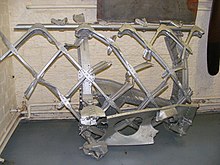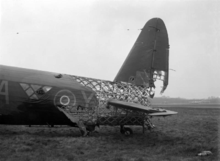Geodetic airframe

A geodetic airframe is a type of construction for the airframes of aircraft developed by British aeronautical engineer Barnes Wallis in the 1930s (who sometimes spelt it "geodesic"). Earlier, it was used by Prof. Schütte for the Schütte Lanz Airship SL 1 in 1909.[1] It makes use of a space frame formed from a spirally crossing basket-weave of load-bearing members.[2] The principle is that two geodesic arcs can be drawn to intersect on a curving surface (the fuselage) in a manner that the torsional load on each cancels out that on the other.[3]
Early examples
[edit]
The "diagonal rider" structural element was used by Joshua Humphreys in the first US Navy sail frigates in 1794.[4] Diagonal riders are viewable in the interior hull structure of the preserved USS Constitution on display in Boston Harbor.[5][6][4] The structure was a pioneering example of placing "non-orthogonal" structural components within an otherwise conventional structure for its time.[6] The "diagonal riders" were included in these American naval vessels' construction as one of five elements to reduce the problem of hogging in the ship's hull, and did not make up the bulk of the vessel's structure, they do not constitute a completely "geodetic" space frame.[citation needed]
Calling any diagonal wood brace (as used on gates, buildings, ships or other structures with cantilevered or diagonal loads) an example of geodesic design is a misnomer. In a geodetic structure, the strength and structural integrity, and indeed the shape, come from the diagonal "braces" - the structure does not need the "bits in between" for part of its strength (implicit in the name space frame) as does a more conventional wooden structure.
Aeroplanes
[edit]
The earliest-known use of a geodetic airframe design for any aircraft was for the pre-World War I Schütte-Lanz SL1 rigid airship's envelope structure] of 1911, with the airship capable of up to a 38.3 km/h (23.8 mph) top airspeed.[7][unreliable source?]
The Latécoère 6 was a French four-engined biplane bomber of the early 1920s. It was of advanced all-metal construction and probably the first aeroplane to use geodetic construction. Only one was built.
Barnes Wallis, inspired by his earlier experience with light alloy structures and the use of geodesically-arranged wiring to distribute the lifting loads of the gasbags in the design of the R100 airship, evolved the geodetic construction method (although it is commonly stated, there was no geodetic structure in R100).[8] Wallis used the term "geodetic" to apply to the airframe; it is referred to as "Vickers-Wallis construction" in some early company documents.[9] "Geodesic" is used in the United States for aircraft structures.[10]
The system was later used by Wallis's employer, Vickers-Armstrongs in a series of bomber aircraft, the Wellesley, Wellington, Warwick and Windsor. In these aircraft, the fuselage and wing were built up from duralumin alloy channel-beams that were formed into a large framework. Wooden battens were screwed onto the metal, to which the doped linen skin of the aircraft was fixed. The Windsor had a woven metal skin.[citation needed]
The metal lattice-work gave a light and very strong structure.[2] The benefit of the geodetic construction was larger internal volume for a given streamlined shape.[9] Flight magazine described a geodetic frame as sheet metal covering in which diamond shaped holes have been cut leaving behind the geodetic strips.[11] The benefit was offset by having to construct the fuselage as a complete assembly unlike aircraft using stressed-skin construction which could be built in sections. In addition, fabric covering on the geodetic frame was not suitable for higher flying aircraft that had to be pressurised. The difficulty of providing a pressurised compartment in a geodetic frame was a challenge during the design of the high altitude Wellington Mk. V. The pressure cabin, which expanded and contracted independently of the rest of the airframe, had to be attached at the nodal points of the structure.[12]
Geodetic wing and fin structures, taken from the Wellington, were used on the post-war Vickers VC.1 Viking, but with a metal stressed-skin fuselage.[13] Later production Vikings were completely stressed-skin construction marking the end of geodetic construction at Vickers.[14]
See also
[edit]References
[edit]Inline citations
[edit]- ^ Nowarra, Heinz J. (1988). Deutsche Luftschiffe: Parseval - Schütte - Lanz - Zeppelin (in German). Friedberg: Ponzun-Pallas-Verlag. ISBN 978-3-7909-0332-4. Retrieved 2 December 2018.
- ^ a b Buttler, p.93
- ^ Buttler, p.94
- ^ a b "Keel Hauled". USS CONSTITUTION MUSEUM. September 2016.
- ^ Brooks, Rebecca Beatrice (27 June 2017). "Construction of the USS Constitution". History of Massachusetts Blog.
- ^ a b Otton, Patrick (1997). USS Constitution Rehabilitation And Restoration. Third International Conference on the Technical Aspects of the Preservation of Historic Vessels Conference Proceedings. San Francisco Maritime Park Association.
- ^ "Archived copy". www.earlyaeroplanes.com. Archived from the original on 12 November 2013. Retrieved 22 February 2022.
{{cite web}}: CS1 maint: archived copy as title (link) - ^ Murray, p.34 and p.44
- ^ a b "Geodetic Aircraft Design – Barnes Wallis Foundation".
- ^ https://archive.org/details/sim_journal-of-aircraft_january-february-2002_39_1, p.18
- ^ Flight magazine, 15 December 1938, p.548
- ^ From Bouncing Bombs To Concorde, Robert Gardner 2006,ISBN 0 7509 4389 0, p.33
- ^ Bailey-Watson, C. B. (24 May 1945), "Vickers Viking", Flight, archived from the original on 4 June 2016
- ^ From Bouncing Bombs To Concorde, Robert Gardner 2006,ISBN 0 7509 4389 0, p.65
Sources
[edit]- Buttler, Tony (2004). British Secret Projects: Fighters & Bombers 1935-1950. Hinckley: Midland Publishing. ISBN 978-1-85780-179-8.
- Murray, Iain (2009). Bouncing-Bomb Man: the Science of Sir Barnes Wallis. Haynes. ISBN 978-1-84425-588-7.
